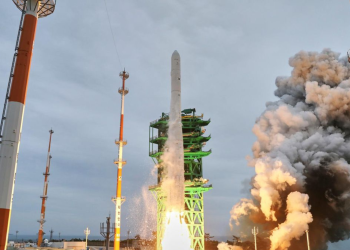South Korea revealed it would start operating a real-time air quality-monitoring public service for the Korean Peninsula and surrounding areas. In particular, the country will use the data collected from Chollian-2B, an environmental observation satellite, to launch the new service. Moreover, South Korea’s Ministry of Science and ICT will operate the real-time air quality observation map with Chollian-2B data.
“The geostationary environmental satellite will quickly provide accurate information on the generation and movement of air pollutants in the future, and will play a central role in improving air quality in Asia, said Chang Yoon-Seok, President of South Korea’s National Institute of Environmental Research (NIER).
Chollian-2B
In February 2020, South Korea successfully launched the world’s first geostationary environment-monitoring satellite, the Chollian-2B, for observing fine dust movement. Previously, the country also launched the Chollian-2A, which is optimized for terrestrial observations. While Chollian-2B is for air quality and ocean observation, its sister satellite, Chollian-2A, is for weather monitoring.
As a Ministry of Science and ICT representative stated, they have completed the geostationary satellites’ development and regular operation. The ministry’s director Lee Chang-Yoon also said they plan to develop and launch more advanced meteorological and environmental observation satellites.
Air Pollutant Data
According to the Ministry of Science and ICT, they will utilize the environmental observation satellite to examine atmospheric pollutants across various Asian regions. For instance, the air quality-monitoring map will offer data on various air pollutant types and provide accurate air pollutant levels. The different observational image information includes nitrogen dioxide, aerosol, ozone, cloud content, and three ultraviolet output types.
South Korea’s Ministry of Oceans and Fisheries (MOF) also participates in the project by delivering sulfur dioxide image information. Officials expect MOF’s contribution to give additional sulfur dioxide concentration data during natural disasters, including forest fires and volcanic eruptions. In addition to these data, NIER’s Environmental Satellite Center will provide formaldehyde and glyoxal concentration levels, which generate photochemical smog.
Currently, the air quality observation service is only available on the NIER Environmental Satellite Center’s official website. However, NIER will upgrade the satellite data service during this year’s second half, extending its public accessibility to mobile platforms. The science ministry also stated it plans to share Chollian-2B’s data with 13 neighboring countries.







